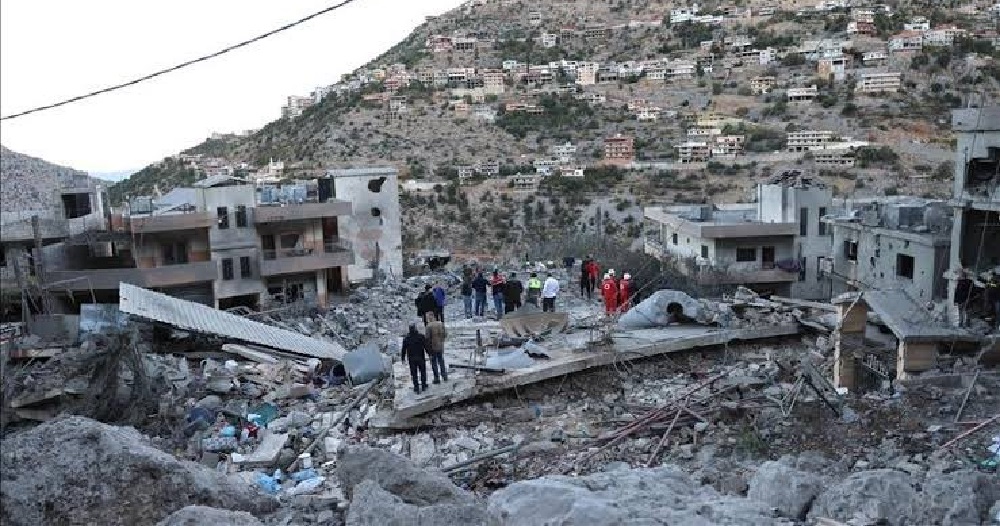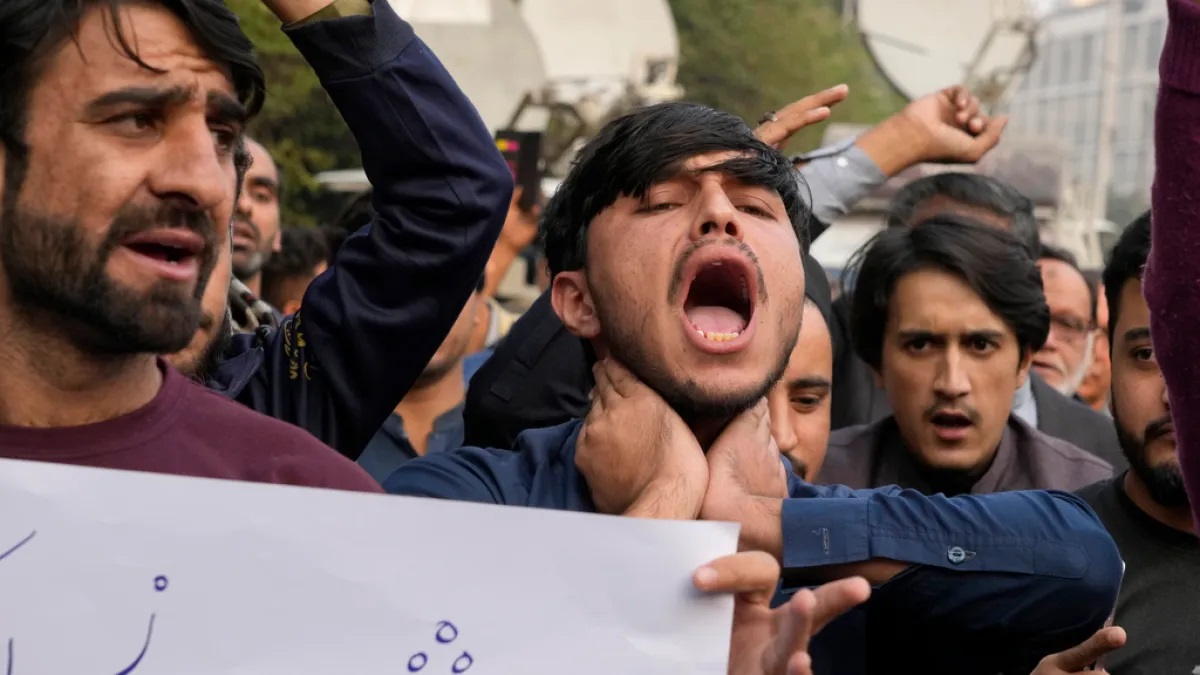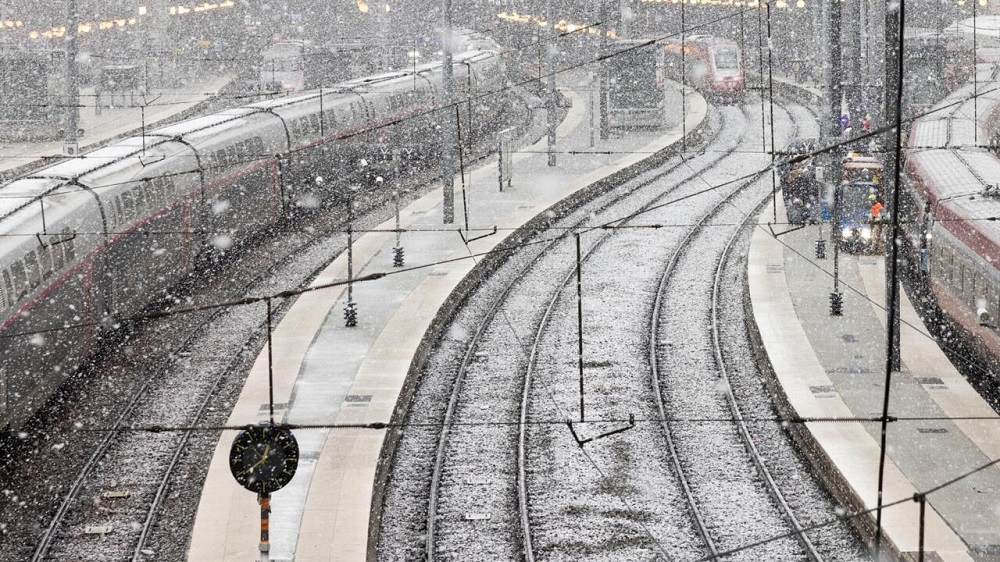Foreign
Israeli airstrikes kill dozens across Lebanon

Israeli airstrikes across Lebanon killed dozens of people on Sunday as the Hezbollah group sustained a string of deadly blows to its command structure, including the killing of its overall leader, Hassan Nasrallah.
Hezbollah confirmed Nabil Kaouk, the deputy head of the group’s Central Council, was killed Saturday, making him the seventh senior Hezbollah leader slain in Israeli strikes in a little over a week. They include founding members who had evaded death or detention for decades.
Hezbollah had earlier confirmed that Ali Karaki, another senior commander, died in Friday’s strike that killed Nasrallah. Israel says at least 20 other Hezbollah militants were killed, including one in charge of Nasrallah’s security detail.
Meanwhile, Israeli warplanes and drones carried out deadly strikes across Lebanon on Sunday. Two consecutive strikes near the southern city of Sidon, about 45 kilometers (28 miles) south of Beirut, killed at least 32 people, the Lebanese health ministry said. Separately, Israeli strikes in the northern province of Baalbek Hermel killed 21 people and injured at least 47.
The Israeli military said it also carried out another targeted strike on Beirut, but did not immediately provide details.
Lebanese media reported dozens of strikes in the central, eastern and western Bekaa and in the south, besides strikes on Beirut. The strikes have targeted buildings where civilians were living and the death toll was expected to rise.
In a video of a strike in Sidon, verified by The Associated Press, a building swayed before collapsing as neighbors filmed. One TV station called on viewers to pray for a family caught under the rubble, posting their pictures, as rescuers failed to reach them. The Lebanese health ministry reported at least 14 medics were killed over two days in the south.
President Joe Biden said Sunday he would speak with Israeli Prime Minister Benjamin Netanyahu, and believes that an all-out war in the Middle East must be avoided.
“It has to be,” Biden told reporters at Dover Air Force Base in Delaware as he boarded Air Force One for Washington.
Meanwhile, wreckage from the strike on Friday that killed Nasrallah was still smoldering. AP journalists saw smoke over the rubble as people flocked to the site, some to check on what was left of their homes and others to pay respects, pray or simply to see the destruction.
In response to the dramatic escalation in Israeli strikes on Lebanon, Hezbollah significantly increased its attacks in the past week, from several dozen to several hundred daily, the Israeli military said. The attacks injured several people and caused damage, but most of the rockets and drones were intercepted by Israel’s air defense systems or fell in open areas.
The army says its strikes have degraded Hezbollah’s capabilities and the number of launches would be much higher if Hezbollah had not been hit.
Israel strikes Houthi targets in Yemen
Also on Sunday, the Israeli military said dozens of its aircraft struck Houthi targets in Yemen in response to a recent attack on Israel. The military said it targeted power plants and sea port facilities in the city of Hodeida.
The Houthis launched a ballistic missile attack on Ben Gurion airport on Saturday when Netanyahu was arriving. The Houthi media office said the Israeli strikes hit the Hodeida and Rass Issa ports, along with two power plants in Hodeida city, a stronghold for the Iranian-backed rebels. The Houthi-run Health Ministry said the strikes killed four people and wounded 40 others.
The Houthis claimed they took precautionary measures ahead of the strikes, emptying oil storages in the ports, according to Nasruddin Ammer, deputy director of the Houthi media office. He said in a post on X platform the strikes won’t stop the rebels’ attacks on shipping routes and on Israel.
Meanwhile, White House national security spokesman John Kirby said Israel’s airstrikes in Lebanon had “wiped out” Hezbollah’s command structure, but he warned the group will work quickly to rebuild it.
Netanyahu on Sunday appointed a former rival, Gideon Saar, to his Cabinet. The move expands Netanyahu’s governing coalition and helps entrench the Israeli leader in office.
Under their agreement, Netanyahu said Saar would be given a spot in the Security Cabinet, the body that oversees management of the ongoing war.
Earlier this month, Hezbollah was also targeted by a sophisticated attack on its pagers and walkie-talkies that was widely blamed on Israel. A wave of Israeli airstrikes across large parts of Lebanon have killed more than 1,030 people – including 156 women and 87 children – in less than two weeks, according to Lebanon’s Health Ministry.
Hundreds of thousands of people have been driven from their homes in Lebanon by the latest strikes. The government estimates around 250,000 are in shelters, with three to four times as many staying with friends or relatives, or camping out on the streets. Hezbollah, a Lebanese group and political party backed by Iran, Israel’s chief regional rival, rose to regional prominence after fighting a devastating monthlong war with Israel in 2006 that ended in a draw.
Hezbollah began firing rockets, missiles and drones into northern Israel after Hamas’ Oct. 7 attack out of Gaza triggered the war there. Hezbollah and Hamas are allies that consider themselves part of an Iran-backed “Axis of Resistance” against Israel.
The conflict has steadily ratcheted up to the brink of all-out war, raising fears of a region-wide conflagration.
Israel says it is determined to return some 60,000 of its citizens to communities in the north that were evacuated nearly a year ago. Hezbollah has said it will only halt its rocket fire if there is a cease-fire in Gaza, which has proven elusive despite months of indirect negotiations between Israel and Hamas led by the United States, Qatar and Egypt.
(The Associated Press)
Foreign
Dozens killed in renewed sectarian violence in Pakistan

More than 80 people have been killed and 156 wounded in three days of sectarian violence in Pakistan’s tribal district of Kurram, near the Afghan border, authorities confirmed.
The violence, which began on Thursday, erupted when gunmen attacked convoys of Shia Muslims travelling under police escort.
More than 40 people, including women and children, were killed in that incident, triggering a series of revenge attacks between Shia and Sunni communities.
After Sunday’s negotiations, government spokesman Muhammad Ali Saif announced that Sunni and Shia leaders had agreed to a seven-day ceasefire.
Provincial officials facilitated the talks despite reports that the negotiators’ helicopter came under fire upon arriving in the region.
“The clashes and convoy attacks on November 21, 22, and 23 have resulted in 82 fatalities and 156 injuries,” a local official said on Sunday. Among the dead, 16 were Sunni and 66 were Shia, according to local authorities.
The Kurram district has long been a flashpoint for tribal and sectarian conflicts over land disputes, with periodic violence between Shia and Sunni groups.
This week’s unrest has forced hundreds of residents to flee, many seeking refuge in the nearby mountains under freezing conditions.
“We’ve been hearing gunfire all night. I sent the women and children of my family to hide in the mountains. The cold is unbearable, but we have no other option,” one Sunni villager said.
This latest bout of bloodshed follows months of deadly clashes in the region, which had already prompted tribal leaders to call for a ceasefire.
October saw a mass funeral for victims of earlier violence, showing the ongoing tensions that have left communities fractured and in fear.
The provincial government has pledged to address the underlying issues fuelling the conflict, but the fragile ceasefire shows the urgent need for sustained peace-building efforts.
For now, the region remains on edge, with many fearing that the violence could resume once the temporary truce ends.
Foreign
Hezbollah launches largest attack on Israel, hits Ashdod naval base, Tel Aviv

Hezbollah says it targeted the Ashdod naval base in southern Israel “for the first time” and Tel Aviv, resulting in 500 air raid sirens sounding across north and central Israel on Sunday, sending up to four million Israelis to underground bunkers. The attack is in response to the powerful Israeli airstrike that killed at least 29 people in Beirut on Saturday.
Hezbollah also said it launched “a strategic and unprecedented operation” in southern Lebanon on Sunday, destroying six Israeli Merkava tanks and inflicting heavy casualties on Israeli forces.
Lebanese group said it also conducted an operation against a “military target” in Tel Aviv using advanced missiles and strike drones. Hezbollah is believed to have launched more than 400 rockets and drones, leading to the injury of 11 Israeli forces and some civilians.
The Lebanese health ministry said Israeli attacks on Saturday killed 84 people, bringing the total death toll to 3,754 since 8 October 2023. The ministry added that 15,626 people have been wounded during this period. On the Israeli side, authorities say at least 82 soldiers and 47 civilians have been killed.
Meanwhile, the European Union’s foreign policy chief Josep Borell called for pressure to be exerted on both the Israeli government and Lebanon’s Hezbollah to accept a US ceasefire proposal.
Israel escalated air attacks on Lebanon on September 23, sending ground troops to southern Lebanon a week later.
Foreign
Winter storm kills one, disrupts travel across Ireland, France, UK

Ireland, Britain, and France faced travel chaos on Saturday, and one person died as a winter storm battered northwest Europe with strong winds, heavy rain, snow, and ice.
Hampshire Police in southern England said a man died after a tree fell onto a car on a major road near Winchester early in the day.
Police in West Yorkshire said they were probing whether a second death from a traffic accident was linked to the storm. It is understood the road was not icy at the time of the incident.
Storm Bert left at least 60,000 properties in Ireland without power and closed roads and some ferry and train routes on both sides of the Irish Sea.
Channel ports and airports in Britain were badly affected, while in France, tens of thousands remained without power after Storm Caetano on Thursday. Hundreds of passengers were stranded when trains were halted by power cuts.
Media footage showed flooding in the west of Ireland, which also caused rail closures in Northern Ireland. Snow impacted travel across Britain.
The heaviest snow hit Scotland and parts of northern and central England, with dozens of flood alerts in place.
The UK Met Office issued snow and ice warnings for those regions, saying there was a “good chance some rural communities could be cut off.”
Scottish hills could see up to 40 centimetres (16 inches) of snow, while winds approaching 113 kilometres (70 miles) per hour were recorded in Britain.
Ferry operator DFDS cancelled services on some routes until Monday, with sailings from Newhaven and Dover in southern England to Dieppe and Calais in France severely affected.
Flights were disrupted at Newcastle Airport due to heavy snow, with some flights diverted to Belfast and Edinburgh.
– Blackouts –
Avanti West Coast, which runs rail services between England and Scotland, advised customers not to attempt travel beyond the northern English city of Preston, as it cancelled numerous trains.
National Highways also issued a “severe weather alert,” warning of “blizzard conditions” affecting Yorkshire and northeast England, with a number of road closures announced.
Met Eireann, the Irish National Meteorological Service, also issued a warning for “very strong winds and heavy rain.”
The worst affected areas for power outages in Ireland were in western and northwestern counties, according to ESB Networks, which runs the country’s electricity system.
“Crews and contractors are deployed and restoring power in impacted areas where it is safe to do so,” it said.
In Britain, the National Grid operator said power had been restored to “many homes and businesses,” but more than 4,000 properties across the country were still without electricity on Saturday—the majority in southwest England.
Some 47,000 homes remained without power in northern France on Saturday, two days after the country was battered by Storm Caetano, power company Enedis said.
Up to 270,000 people had been cut off due to the storm, but Enedis said it had 2,000 technicians working to reconnect electricity lines torn down by winds of up to 130 kph.
Several hundred passengers were stranded on two trains in western France halted by power cuts.
Some 200 people on a train going from Hendaye to Bordeaux and 400 on a high-speed TGV going from Hendaye to Paris spent up to nine hours in the carriages.
Junior transport minister Francois Dourovray told RTL radio that up to 1,000 passengers on different trains were affected by the power cut.
AFP
-

 News24 hours ago
News24 hours agoJoint Security Patrol Team wastes Kidnapper in gun duel along Enugu/Ukwu Road
-

 Metro23 hours ago
Metro23 hours agoBREAKING: UK Court Fines Popular Journalist David Hundeyin £95000 for Libel
-

 News21 hours ago
News21 hours agoObasanjo narrates how he escaped becoming drug addict
-

 News11 hours ago
News11 hours agoMany Pastors Are Not Enjoying Their Marriages Due To Wives’ Behaviours – Bamiloye
-

 News11 hours ago
News11 hours agoAbia bans unauthorised free medical outreaches
-

 News21 hours ago
News21 hours agoWe saved $20bn after Petrol Subsidy Removal and FX Rate Reforms, Says Finance Minister
-

 Metro11 hours ago
Metro11 hours agoArmy destroys 34 illegal refineries in Niger Delta
-

 Metro11 hours ago
Metro11 hours agoFarmer allegedly beats suspected thief to death in Ondo








